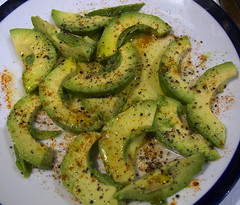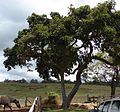
Persea americana

Avocados, also known as alligator pears, are a delightful, nutritionally dense, and easily digestible addition to a healthy diet. These tasty fruits have often been recommended as a baby's first food and for convalescents. Include them, not merely as an occasional treat, but as a regular part of your diet.
(Photo credit: Tom Dubé)
Protein
If you are a vegetarian, vegan, or raw-foodist seeking more protein, and/or trying to cut down on animal proteins in your diet, avocados are a great nutritional ally. These fruits provide all 18 essential amino acids. Because they contain fiber, avocado protein is readily absorbed by the body -- unlike the protein in meat, which is difficult for most people to digest.Carotenoids
Although many people associate carotenoids only with red and orange produce, avocados are also an excellent source of this phytonutrient. Avocados offer a diverse range of carotenoids including not only the better known ones such as beta-carotene, alpha-carotene and lutein, but also lesser known varieties of this type of phytonutrient such as neoxanthin, zeaxanthin, chrysanthemaxanthin, neochrome, beta-cryptoxanthin and violaxanthin. Every time you consume foods rich in carotenoids, you deliver high quality vitamin A to your body, thereby protecting eye health. Carotenoids also enhance the functioning of the immune system and promote healthy functioning of the reproductive system. Since carotenoids are fat soluble, eating avocados optimizes the absorption of these nutrients.Healthy fats
The fat content, which causes some uninformed health "experts" to deem avocados as unhealthy, actually provides protection against heart diseases. Many people now take supplements in order to consume more omega-3 fatty acids to lower their risk of heart disease. Avocados are rich in omega-3, delivering 160 milligrams per cup of alpha-linolenic acid. Studies have shown that oleic acid improves cardiovascular health. Oleic acid is the primary fatty acid in avocados.
Avocados provide the healthy kind of fat that your body needs. Like olive oil, avocados boost levels of HDL (the "good" cholesterol). HDL cholesterol can help protect against the damage caused by free radicals. This type of cholesterol also helps regulate triglyceride levels, preventing diabetes. A study published early this year in the Canadian Medical Association Journal found that a vegetarian diet, which includes HDL fats, can reduce levels of LDL (the "bad" cholesterol) as effectively as statin drugs.
Many people now take supplements in order to consume more omega-3 fatty acids to lower their risk of heart disease. Avocados are rich in omega-3, delivering 160 milligrams per cup of alpha-linolenic acid. Studies have shown that oleic acid improves cardiovascular health. Oleic acid is the primary fatty acid in avocados.
Avocados provide the healthy kind of fat that your body needs. Like olive oil, avocados boost levels of HDL (the "good" cholesterol). HDL cholesterol can help protect against the damage caused by free radicals. This type of cholesterol also helps regulate triglyceride levels, preventing diabetes. A study published early this year in the Canadian Medical Association Journal found that a vegetarian diet, which includes HDL fats, can reduce levels of LDL (the "bad" cholesterol) as effectively as statin drugs.
Anti-Inflammatory
The combined effect of the deluxe package of nutrients contained in avocados offers powerful anti-inflammatory benefits. Avocados' unique combination of Vitamins C and E, carotenoids, selenium, zinc, phytosterols and omega-3 fatty acids helps guard against inflammation. This means avocados can help prevent or mitigate against both osteo- and rheumatoid arthritis. Avocado seeds provide a number of benefits. Watch for an upcoming page.Choosing and Eating
To get the most nutritional value from avocados, avoid ones which became over-ripe. You can identify these at the store because they feel overly soft when you hold them and will have dents. A ripe avocado should have no dents in its skin and will feel slightly soft when squeezed. You can also buy unripe avocados, which feel very hard when gripped, and permit them to ripen at home. Research has shown that the greatest concentration of carotenoids in avocado occurs in the dark green flesh that lies just beneath the skin. You don't want to slice into that dark green portion any more than necessary when you are peeling an avocado. For this reason, the best method is what the California Avocado Commission has called the "nick and peel" method. In this method, you actually end up peeling the avocado with your hands in the same way that you would peel a banana.- The first step in the nick-and-peel method is to cut into the avocado lengthwise, producing two long avocado halves that are still connected in the middle by the seed.
- Next you take hold of both halves and twist them in opposite directions until they naturally separate.
- At this point, remove the seed and cut each of the halves lengthwise to produce long quartered sections of the avocado.
- You can use your thumb and index finger to grip the edge of the skin on each quarter and peel it off, just as you would do with a banana skin.
Starting seeds
 Avocados are the fruit from Persea americana, a tall evergreen tree that can grow up to 65 feet in height.
Avocados are the fruit from Persea americana, a tall evergreen tree that can grow up to 65 feet in height.The avocado tree, when grown by a hobby gardener is normally grown from seeds removed from ripened fruit. There are two acceptable methods of doing this, either by sprouting the seed in water or by actually planting the seed in soil.
Many people start avocado trees as novelty house plants by piercing the seed with its pointed end up, partially through with toothpicks on three or four sides to hold it on the top of a jar or vase partly filled with water and few pieces of charcoal (to keep the water sweet) just covering the base. In 2 to 6 weeks, when roots and leaves are well formed the plant is set in potting soil. Unless they're moved into soil within a few weeks or months after germination, they'll begin to deteriorate. They are also easily sprouted in a well-drained 4- or 5-inch pot of porous, fertile soil. The top of the seed should just barely peek above the surface of the soil.
If the soil is kept fairly moist and the temperature is between 60 and 70 degrees, the seed will begin to sprout and a pretty, leafy plant will develop. When the seedling reaches 12 inches, it should be pinched back to about 6-8 inches to produce a rounder, fuller plant. Once they've filled their pots up with healthy roots, they should be re-potted in a larger container. Avocados grown inside thrive in sun or in a good, lighted location. Indoor trees need low night temperatures to induce bloom. Water the trees so that the soil never becomes really dry but isn't ever soggy and waterlogged. Well-rooted plants should be fertilized with a balanced houseplant food every two or three weeks in the summer and about every six weeks during the winter. It's also a good idea to mist the leaves of your Avocado if the air in your home is very dry.
Avocado in the garden
 Avocado trees are very versatile in their adaptability to different soils, but they prefer a rich loose sandy loam. They will not survive in locations with poor drainage. . The desirable pH level is generally considered to be between 6 and 7.
Avocado trees are very versatile in their adaptability to different soils, but they prefer a rich loose sandy loam. They will not survive in locations with poor drainage. . The desirable pH level is generally considered to be between 6 and 7.Transplanting should be done in early spring. Potted plants should be moved outdoors gradually, so they can acclimatize themselves, and adjust to the new elements. They will grow in shade and between buildings, but are only productive in full sun.
The root system is extensive and will choke out nearby plants, so they should be given plenty of room--up to 20 feet. However two or three trees can be planted in a single large hole to save garden space and enhance pollination.
Once established the avocado is a fairly tough tree. Once the tree is a year old, it should be fed four times yearly using a balanced fertilizer. Older trees benefit from feeding with nitrogenous fertilizer applied in late winter and early summer.














